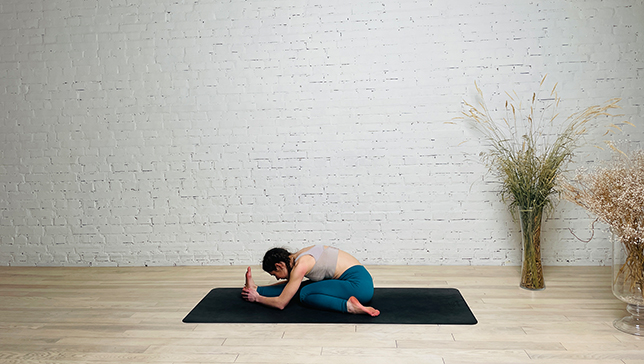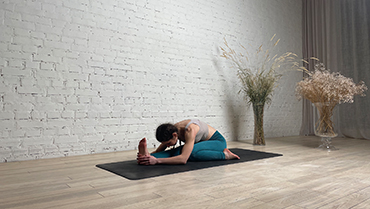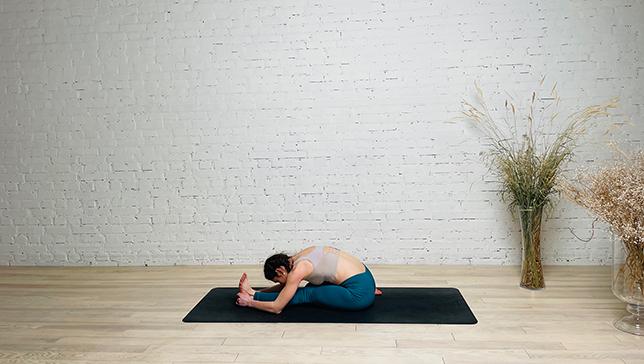One Leg Folded Forward Bend Pose - Trianga Mukhaikapada Paschimottanasana

Contents
One Leg Folded Forward Bend Pose or Trianga Mukhaikapada Paschimottanasana is a seated forward bend that stretches the back of the body and calms the mind. The name comes from several Sanskrit words:
- Triang, meaning “three limbs”;
- Mukha, meaning “face”;
- Eka, meaning “one”;
- Pada, meaning “foot”;
- Paschima, meaning “west” or “back of the body”;
- Uttana, meaning “intense stretch”;
- Asana, meaning “posture” or “pose.”
From Dandasana (Staff Pose), one leg is folded back at the knee so it rests along the corresponding hip, while the other leg remains straight. The torso then folds at the hips as the arms reach for the extended foot. This yoga asana must be done on an empty stomach, preferably in the morning or at least 4 hours after a heavy meal.
Pose Detail
- Difficulty: Beginners
- By Type: Flexibility Yoga Poses, Hip Opening Yoga Poses, Strengthening Yoga Poses
- Body Position: Forward Bend Yoga Poses, Seated Yoga Poses
- By Benefit: Yoga Poses For Digestion, Yoga Poses For Stress Relief
Step-by-Step Instructions
Benefits and Contraindications
Regulates the digestion system
Stimulates and tones the abdominal organs
Makes the spine more flexible
Calms the mind
Opens the hips
Improves the flexibility in the hamstrings, hips and knee joint
Restores the body from long travel
Injury or surgery to the back, hips, ankles, shoulders, knees, neck , spine, and the arms
Weak digestive system or any problem with the abdominal organs
Hypertension
Migraine
Pregnancy after 3rd trimester
Photo poses in different angles


Modifications and Props For Beginners
People with tight hip joints can practice this pose with props.
- Sit on a yoga block to perform the asana using your sit bones. This helps in maintaining balance with one folded leg and prevents the tilting of the upper body to one side.
- Wrapping a strap around the soles of the stretched foot makes the leg approachable. People who are unable to reach their foot while bending forward can find the yoga strap handy. They can hold the ends of the strap rather than holding the feet or hooking the wrist around the foot.
- You can also use a chair to ease the pose a bit. Keep a chair in front of you and stretch the leg under it. While bending forward you can rest your arms and head on the chair. This makes forward bending less challenging.
Useful Tips
Here are some useful tips that can make the practice of Trianga Mukhaikapada Paschimottanasana easier and more comfortable.
- Warm-up: It’s important to warm up your body before attempting this pose. You can do some gentle stretches and movements to prepare your muscles and joints.
- Start slow: Begin by bending your left leg and bringing the sole of your left foot to your inner right thigh. Slowly bend forward, reaching your hands towards your right foot. Hold for a few breaths, then repeat on the other side.
- Engage your core: As you fold forward, engage your core muscles by drawing your navel towards your spine. This will help you maintain balance and stability in the pose.
- Keep your spine straight: Avoid rounding your back as you fold forward. Instead, lengthen your spine and reach your chest forward.
- Use props: If you’re not able to reach your foot comfortably, use a strap or a block to help you. You can loop the strap around your foot and hold onto the ends, or place a block under your hands to bring the floor closer to you.
- Breathe deeply: Take slow, deep breaths as you hold the pose. This will help you relax and release tension in your body.
- Don’t force it: If you feel any pain or discomfort, back off the pose and modify as needed. It’s better to take it slowly and listen to your body than to push yourself too hard and risk injury.
Remember to be patient and consistent with your practice. With time and practice, you’ll gradually deepen your stretch and feel more comfortable in the pose.
Frequently Asked Questions
Variations
- One Leg Folded Forward Bend With Strap
- Seated Forward Bend Pose Wheel
- Standing One Leg Folded Forward Bend